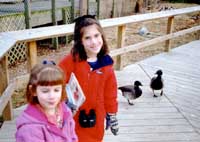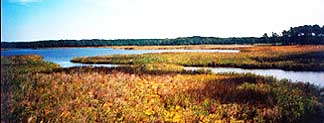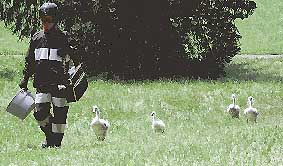 By Martha Blume By Martha Blume
My daughters and I came to Horsehead Wetlands Center, home of the Wildfowl Trust of North America, looking for trumpeter swans, which are - like us - transplants from Alaska.
photo by Martha Blume
Margaret and Phoebe Blume start their search for trumpeters at Horsehead Wildlife Center.
Our car carried us away from the traffic and the rush of the cities and suburbs that we'd come to know as home, east across the Bay Bridge to Kent Island in search of a quieter time and place. Leaving Route 50 behind, we followed signs through Grasonville, past the post office, through the town, then down a dusty dirt road.
"A prairie!" declared my young daughter, spying the seemingly endless acres of marshland stretched out before us. Rivers of yellow salt marsh grass meandering through ripples of sea lavender and goldenrod, flanked by the ever present reed grass, did indeed resemble a seaside prairie of sorts. Our prairie merged into a forest of loblolly pine, and soon we saw the visitor center that welcomed us to the 500 acres that are Horsehead Wetlands Center, home of the Wildfowl Trust of North America.
My daughters and I came to Horsehead looking for trumpeter swans, which are - like us - transplants from Alaska. Just as we did not expect to find a prairie on the Chesapeake shore, we were pleasantly surprised to discover that at Horsehead, many things are not quite where you'd expect them to be.
Homesteading at Horsehead
Inside the visitor center, snakeskins, horseshoe crab shells, pine cones and other touchables beckoned my daughters, while I was drawn to the spotting scope that focused on a small pond. Waterfowl splashed about, but it was a pair of snow white swans with striking black bills that caught my eye. Chris Snow, site manager, told me that these were indeed trumpeter swans. But these were part of the Wildfowl Trust of North America's captive population rather than the famous visiting swans. The birds are pinioned, meaning the tip of the wing or a tendon in the wing is cut so the birds cannot fly away. They are there for visitors to observe - and in hope they will breed.
Captive or not, the birds were impressive. With wingspans of over eight feet, trumpeter swans are the largest waterfowl in North America and the largest swans in the world. The trumpeter's neck is twice the length of its body. A convoluted trachea allows it to produce its characteristic bugle call: "ko-ho, ko-ho!"
Learning the story of the migrating trumpeter swans, I realized we had a lot in common. The swans we sought were plucked out of their nests as two-week-old youngsters from the wild Chugach National Forest in Cordova, Alaska, in June 2000. My daughters, at ages one-and-one-half and four, were similarly plucked from their home in Anchorage in June 1998. The swans learned to follow around adoptive moms and dads - swan handlers from the Trumpeter Swan Migration Project - in upstate New York. My daughters followed their biological parents to Rhode Island where they learned to go to school like their father, a graduate student at the university.
The swans ultimately learned, in small families of four to five, to follow an ultralight aircraft to Horsehead Wetlands Center on the Chesapeake Bay, where they touched down on January 18, 2001. My daughters rode in the back of our Subaru to the suburbs of the Chesapeake Bay where we settled in January 2000. Suddenly, here we were all together for the first time - and out of place. We were here to stay, while the swans' purpose for coming, unbeknownst to them, was to recreate a migratory ritual lost for some 200 years.
Until the mid-1800s, the swans called this place home. Back then, trumpeter swans nested by the hundred-thousands south of the tundra line along the East Coast, in places like upstate New York, and wintered on the shores of Chesapeake Bay. European settlers coveted the swans for their meat and feathers. Feathers were made into pens, used to adorn ladies hats and to fill pillows, comforters and powder puffs. Now wild, migratory trumpeters breed only in Alaska, the Rocky Mountain region and western Canada, though some resident populations have been introduced in the West, Midwest and Ontario.
Two men dreamed that migratory flocks could live along the East Coast again. Dr. William Sladen - who founded the Wildfowl Trust at Horsehead and now directs the Trumpeter Swan Migration Project at Airlie Center in Warrenton, Virginia - teamed up with William Lishman, a Canadian sculptor and aviator whose work is fictionalized in the Hollywood movie, Fly Away Home. Lishman trained Canada geese to follow humans flying ultralight aircraft along traditional migratory routes. In three out of six trials in the 1990s, the birds used the same routes to return to nesting grounds on their own in the spring. Lishman is also experimenting with sandhill cranes and endangered whooping cranes.
 photo courtesy of the Trumpeter Swan Migration Project photo courtesy of the Trumpeter Swan Migration Project
Swan Moms and Dads
Binoculars in hand, the girls and I went about exploring. Naturally, our first stop was the Alaska Pond. My four-year-old daughter, born in Alaska, felt right at home amid the cacophony of tundra swans, the trumpeters' smaller cousins; emperor geese; white-fronted geese; and Canada geese. Like the trumpeters in the visitor center pond, these birds are part of the captive collection of Horsehead, and it is hoped that they will breed here.
Unlike songbirds, which migrate based on instinct, waterfowl like geese and swans learn migration routes from their parents, during their first flight from their breeding grounds to their wintering grounds. Swans mate for life. Parents share responsibilities, and cygnets remain closely attached to their parents for their first year. Amazingly, they only have to fly the route one time to know it by sight. If they have no parents or surrogate parents to follow, they become "nuisance species," like Canada geese that fill up so many ponds where they've taken up residency. Sladen proved this during his goose experiments. If the geese were trucked from Ontario to Airlie, they became resident geese; if they were shown the route from the air, using ultralights as surrogate parents, they became migratory flocks.
As the wild swans' moms and dads, swan handlers - among them Laurie Kramer, a research assistant; team leader/pilot Brooke Pennypacker; and volunteer pilot Mark Reese - wore black costumes with white stripes, red masks and goggles. These high-contrast uniforms are unlike anything the swans will see in nature or on other humans. So the peculiar costuming of the surrogate parents helps them retain their wildness rather than conditioning on humans.
During the training, cygnets heard tapes of both ultralights and swan sounds. They waddled behind their new moms and dads on land and paddled behind them on water. When the cygnets could fly, the pilots led them through the air with their ultralights. When they could fly 45 or more miles per flight, the researchers knew they were ready for the trip south.
Photoperiodism, the increase of daylight in the spring, drove my daughters and myself out of our house on this fine, spring-like afternoon. Photoperiodism also gives the swans their restless need to fly north. Now the adoptive parents hope that sometime this month the birds will feel the call to return on their own to their training grounds in upstate New York.
Swan handlers believe that this year's swans - UltraSwan3s of wild Alaskan stock - have a genetic advantage. The first flight of captive-raised swans, in December 1997, trained to follow an ultralight aircraft at Airlie Center near Warrenton, Virginia, across the Potomac and the Chesapeake Bay to Dorchester County, Maryland, where they wintered, and two out of three returned to Airlie on their own the following spring.
A second attempt with captive swans along a traditional migratory route was fraught with problems due to bad weather in the Buffalo area. In 19 98, 20 captive swans from Airlie were driven to western New York for flight training. Due to early injuries in their flight south, they were trucked to Horsehead, with stops every 40 miles or so to allow them to see landmarks from the air. Thirteen of these survived the winter at Horsehead, but none initiated a return flight the following spring. They were trucked again to New York. In January of 2000, one of these UltraSwan2s migrated south and was tracked as far as Pennsylvania. This swan actually flew back to New York, on its own, the following spring. 98, 20 captive swans from Airlie were driven to western New York for flight training. Due to early injuries in their flight south, they were trucked to Horsehead, with stops every 40 miles or so to allow them to see landmarks from the air. Thirteen of these survived the winter at Horsehead, but none initiated a return flight the following spring. They were trucked again to New York. In January of 2000, one of these UltraSwan2s migrated south and was tracked as far as Pennsylvania. This swan actually flew back to New York, on its own, the following spring.
photos courtesy of the Trumpeter Swan Migration Project
During the cygnets’ feeding, handling and familiarization with the gliders, humans wear distinctive costumes to keep the birds from growing accustomed to any but these odd-looking people.
Humans Dangers Still Lurk
Ten UltraSwan3 trumpeters followed the ultralights south, but only nine will attempt to make the trip back to their summer home. One of the swans was shot in the head with a pellet gun on January 29, 11 days after arrival on the Chesapeake. At 11:30 that morning, two Canadian research interns visited the flock, which was feeding and interacting as expected. The swan was found shot to death shortly after noon.
Team leader Brooke Pennypacker, who had spent so many months with the swans, described the shooting as "senseless."
Sladen says the incident emphasizes the need to educate people about the distinction between the "undesirable alien resident mute swans, that have been the subject of much discussion recently," and the two more "valuable" species: trumpeters, last seen wintering in the Chesapeake Bay almost 200 years ago, and native, migratory tundra swans that winter here.
Sal Amato, senior resident agent at the U.S. Fish and Wildlife Service, told me he is still investigating the case. Violation of the federal Migratory Bird Treaty Act is a misdemeanor, punishable by a maximum fine of $2,000.
Wild swans also risk danger from humans in the form of habitat destruction, illegal hunting and the ingestion of now-banned lead shot remaining from earlier years on the bottom of lakes and ponds, where trumpeters are able to feed because of their unusually long necks. In this second year of the Trumpeter Swan Migration Project wintering at Horsehead, this killing was the first tragedy of human origin.
Of Raptors and Residents
"What's a prairie pothole?" asks my literate daughter. We pass a sign explaining that the ducks in this pond normally live in watering holes created by glacial action along the Central and Mississippi flyways. Many of these ducks don't belong in Chesapeake Bay either, but we're glad to see them.
While the girls and I watch the resident ducks, I notice movement behind us. A black vulture perches on a fence a few feet away, eying us carefully. He seems to live there, too. It appears that one of his wings doesn't work, and he can only hop about.
We find other raptors - red-tailed hawks, a bald eagle, and some owls - in large flight cages. These birds, too, have been injured or cannot live in the wild for other reasons. We liked the owls best. The barred owls seemed to wink at us with their large brown eyes, like coffee floating in big saucers, while the great horned owls hissed and paced at our intrusion.
When Sladen founded the Wildfowl Trust in 1979, he envisioned a place where visitors could observe both captive birds and native wildlife in a natural habitat. The raptors in these cages help with Horsehead's education programs, which reach over 10,000 children and adults annually.
"What's that?" ask my daughters again, pointing to a series of boardwalks roofed with netting. Inside the aviary, we find a duck watcher's treasure: ruddy ducks, wood ducks, canvasbacks, redheaded ducks, hooded mergansers, goldeneye, scaup and Brant geese, all indigenous to the Chesapeake. Best of all, there are male and female of every species and they are close enough to be seen without binoculars. We pull out our Peterson's guide and dig in. It is almost too easy.
On Marshy Creek Trail
Satisfied with our duck identification, we needed a bigger challenge. We chose the Marshy Creek trail, which promised a reward in just one-third mile, and set out on a sometimes muddy path, strewn with pine cones and needles. Boots would have come in handy, but we managed to find high ground at every wet intrusion and kept on going. Several miles of trails at Horsehead, so named for the shape of the peninsula, lead visitors through wet meadow, woodland and salt marsh marked with plant identifiers for the botanically curious.
Morale had begun to sink as quickly as our sneakers when we got our reward. A wooden observation tower rose to the right of the trail, the diversion my little ones needed. Climbing one foot at a time, we reached the top and received a splendid view of a marshy wetland, complete with a good look at a great blue heron flying overhead. The grasses shone truly golden in the afternoon sun.
No sign of the trumpeters we'd come to see, though.
Fran Peters, on weekend duty at the visitor center, had alerted us that they were last seen at the Cabin Creek landing, just off the grounds of the Wetlands Center. We knew to look for immature swans, with gray feathers and pink bills, since trumpeters don't adorn their white plumage until their second year and reach maturity until they are three or more.
My little ones had had enough birding for one afternoon. Perhaps we would drive over to Cabin Creek and have a look there before heading back across the Bay Bridge to home and dinner. Thoughts of a good day kept us all quiet on our walk back to the parking lot.
Suddenly a distinctive "ko-ho, ko-ho!" disturbed our meditations. Looking up, we saw three of the sought-after trumpeters, with tell-tale pink bills and yellow radio collars around their necks. Gangly but graceful, weighty but light as feathers, they were the reward we'd hoped for. Seeing them fly, I couldn't help but wonder if they have any memory of their Alaskan home.
Any day now, those swans will feel the call to head north, reversing the trail paved by their human parents and recreating the pattern set by their ancestral parents thousands of years ago. Perhaps next autumn, they'll return on their own to the prairie of the Chesapeake for restoration, and so will we.
Seek the trumpeter swans at Horsehead Wildlife Center, at 600 Discovery Lane, in Grasonville 9-5 daily. $3: 410/827-6694 · www.wildfowltrust.org. Or plan an expedition to the home of the trumpeter swan Migration Project, at Environmental Studies at Airlie, in Warrington, Virginia: 540/341-3239 · www.trumpeterswans.org.
Copyright 2001
Bay Weekly
|